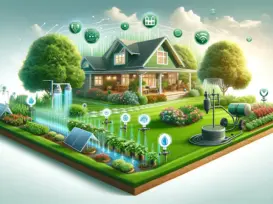Grus Home Energy - water conservation technologies
Innovative Water Conservation Technologies: Pioneering Solutions for Sustainable Management
Innovative Water Conservation Technologies: Pioneering Solutions for Sustainable Management
Water is the lifeblood of our planet, crucial for sustaining ecosystems, agriculture, and human civilization itself. However, with the increasing demand for freshwater due to population growth and economic development, and the strain on water resources due to climate change and pollution, the sustainable management of this vital resource has never been more important. A plethora of innovative water conservation technologies are emerging to address these challenges, offering new ways to save, purify, and use water more efficiently.
One of the key areas of focus in water conservation technology is the improvement of agricultural water use. Agriculture consumes more water than any other source and wastes much of it through inefficiencies. Cutting-edge irrigation systems, like drip and precision irrigation, deliver water directly to the roots of plants, significantly reducing evaporation and runoff. Sensors and smart controllers can monitor soil moisture and automate watering schedules, ensuring plants get precisely the amount of water they need.
Another groundbreaking development is in the area of water recycling and reuse. Greywater systems are becoming increasingly sophisticated, allowing households and businesses to reuse water from sinks, showers, and washing machines for irrigation and flushing toilets. On a larger scale, municipal water treatment plants are now using advanced purification technologies to turn wastewater into potable water. Through processes such as reverse osmosis, UV treatment, and advanced filtration, water that was once waste is now safely returned to the tap.
Rainwater harvesting is another ancient technique that has been reimagined with modern technology. Today’s rainwater collection systems are equipped with first flush diverters, fine mesh filters, and UV purifiers to ensure the collected water is clean and safe to use. By capturing rainwater, pressure on municipal systems is reduced, and individuals can contribute to their local water supply.
Desalination has also been a game-changer, especially for water-scarce regions near the ocean. The process of converting seawater to freshwater has traditionally been energy-intensive and costly, but new technologies are aiming to change that. Innovations such as forward osmosis, energy recovery devices, and the use of renewable energy sources are making desalination more energy-efficient and environmentally sustainable.
Leak detection technology represents another vital tool in the water conservation toolkit. Advances in acoustic sensors, satellite imagery, and AI-powered analytics enable water utilities to identify and repair leaks much more quickly than before, saving millions of gallons of water that would otherwise be lost.
Finally, the rise of the Internet of Things (IoT) and big data analytics in water management cannot be overstated. Smart meters and sensors provide real-time data on water use, quality, and system performance. This data can be used to optimize water distribution, predict maintenance needs, and encourage conservation behaviors through user feedback.
In conclusion, innovative water conservation technologies offer a beacon of hope for a more sustainable future. By embracing these solutions, we can enhance the efficiency of our water use, protect our ecosystems, and ensure that clean, fresh water is available for generations to come. The key to success will be the widespread adoption and continued investment in these pioneering technologies, coupled with policy support and public education on the importance of water conservation.
©2025 All Rights Reserved. Grus IoT Co.,Ltd.
